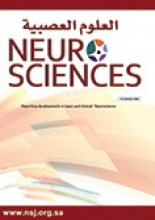Abstract
OBJECTIVE: To study the prevalence of sternalis muscle in the Kingdom of Saudi Arabia (KSA) and resolve the question of its genesis by studying the innervation of this uncommon variant of anterior chest wall musculature.
METHODS: A morphological study of 75 adult cadavers of both sexes was carried out over a 5-year period by macroscopic dissection. We also retrospectively studied the medical records of 1580 adult females who had undergone screening and diagnostic mammographic imaging at King Khalid University Hospital, Riyadh, KSA, from 1997 to 2001.
RESULTS: Out of 75 cadavers studied, 3 cases of sternalis muscle were observed. Two adult male cadavers had well developed bilateral sternalis muscles whereas one female cadaver exhibited right sided unilateral sternalis. All 5 sternalis muscles were positioned vertically, in a parasternal position superficial to the medial part of pectoralis major and innervated by branches of intercostal nerves. None of the 1580 women, however, who had undergone mammographic imaging were found to be sternalis positive.
CONCLUSION: Consistent with other geographic populations of the world, the frequency of sternalis in KSA is approximately 4%; however, its innervation by the intercostal nerves, as observed in our study is not common. This study highlights the need for familiarity with sternalis, which may mimic a focal density in medial breast craniocaudal mammograms and may be encountered during reconstructive surgery of breast and chest wall.
- Copyright: © Neurosciences
Neurosciences is an Open Access journal and articles published are distributed under the terms of the Creative Commons Attribution-NonCommercial License (CC BY-NC). Readers may copy, distribute, and display the work for non-commercial purposes with the proper citation of the original work.






